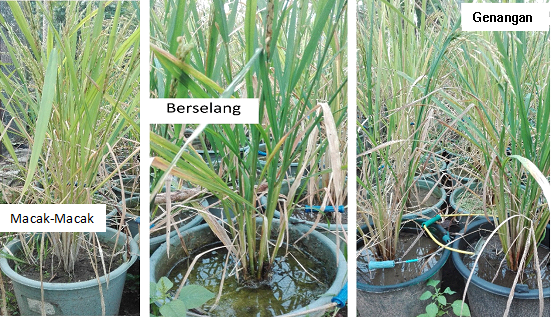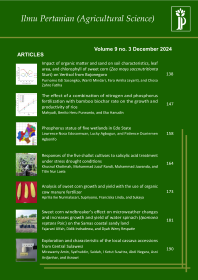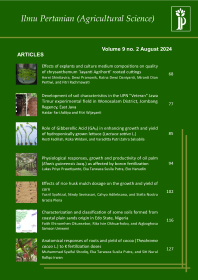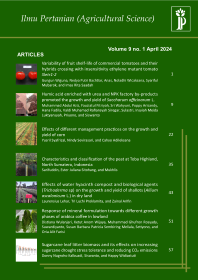
Effect of saline irrigation method on the growth of rice (Oryza sativa L.)
Adlian Adlian(1*), Budiastuti Kurniasih(2), Didik Indradewa(3)
(1) Faculty of Engineering and Agriculture, Nani Bili Nusantara University, Sorong, Papua Barat
(2) Department of Agronomy, Faculty of Agriculture, Universitas Gadjah Mada Jln. Flora, Bulaksumur, Sleman, Yogyakarta 55281
(3) Department of Agronomy, Faculty of Agriculture, Universitas Gadjah Mada Jln. Flora, Bulaksumur, Sleman, Yogyakarta 55281
(*) Corresponding Author
Abstract
A field experiment was carried out to study rice growth under salinity stress in permanently flooded, intermittent, and saturated soil conditions. The experiment was conducted at field station of Faculty of Agriculture, Universitas Gadjah Mada located in Bantengan village, Banguntapan, Bantul, DIY, from August to November 2015. The treatments were arranged in a split-plot randomized complete block design, consisting of three irrigation methods as the main plot and two levels of salinity as the subplot, thereby resulting in six treatment combinations with three replications within each combination treatment. The three irrigation methods were permanent irrigation (flooded soil), intermittent irrigation (wet/dry soil), and irrigation above field capacity (saturated soil). The two levels of salinity were fresh water as control treatment (EC 0.3 dS.m-1) and saline water (EC 5 dS.m-1). The results of the experiment showed that there was no significant interaction effect of irrigation method and salinity on all observed rice growth variables. Salt stress negatively affected the rice growth, including plant height, plant dry weight, leaf area, and leaf area ratio (LAR). Irrigation method significantly affected plant dry weight and number of tillers at 3 and 9 weeks after planting. Permanent irrigation resulted in the highest plant growth compared to intermittent irrigation and above field capacity condition.
Keywords
Full Text:
PDFReferences
Abrol, I. P. 1986. Salt-Affected Soils: Problems and prospects in developing countries. in: global aspects of food production. p.283-305. Ed. M.S. Swaminathan; S.K. Sinha. Oxford: Tycooly International.
Al-Zu’bi, Y. 2007. Effect of irrigation water on agriculture soil in Jordan valley: An example from arid area conditions. J. Arid Environ., 70:63-79.
Dat, J. F., C. Parent, N. Capelli, A. Breger, and M. Crevecoeur. 2006. Sensing and signaling during plant flooding. J. Plant Physiology and Biochemistry., 42 : 273 -282.
Donggulo, C.V. 2017. Pertumbuhan dan hasil tanaman padi (Oryza sativa L.) pada berbagai pola jajar legowo dan jarak tanam. J. Agroland., 24:27-35.
Erdem, T., Y. Erdem, H. Orta, and H.Okursoy. 2006. Water-yield relationships of potato under different irrigation methods and regimens. J. Science and Agriculture., 63:226-231.
FAO. 2005. Global network on integrated soil management for sustainable use of salt-affected soils. http://www.fao.org/tempref/agl/agll/docs/misc23.pdf.
Gardner, F.P., R.B. Pearce dan R. L. Mitchell. 1991. Fisiologi tanaman budidaya. Terjemahan: Herawati Susilo. UI Press, Jakarta.
Gribaldi, R.A. Suwignyo, M. Hasmeda, and R. Hayati. 2014. Pengaruh pemupukan terhadap perubahan morfofisiologi dan varietas padi pada kondisi cekaman rendaman. J. Agron. Indonesia., 42:17-23.
Hardjowigeno, S., H. Subagyo, dan R. M. Luthfi. 2004. Morfologi dan klasifikasi tanah sawah. di dalam: Tanah sawah dan teknologi pengelolaannya. Pusat Penelitian Tanah dan Agroklimat. Departemen Pertanian, Bogor.
Jeki. 2016. Indeks sensitivitas stress beberapa varietas padi gogo pada cekaman kekeringan. J. Agrotekbis,. 4:369-373.
Manderscheid, R., M. Erbs and H.J. Weige. 2012. Interactive effects of freeair CO2 enrichment and drought stress on maize growth. J. Eur Agron., 110:185-196.
Salisbury, F. B and Ross, C.W. 1992. Plant physiology, Hormones and plant regulators: auxins and gibberellins. J. American Plant Sci., 5:357-381.
Shereen, A., Mumtaz, S. Reza, S. Khan M.A. Solangi, S. 2005. Salinity effect on seedling growth and yield components of different inbred rice lines. J. Bot., 37:131-139.
Tavakkoli, E., F. Fatehi, S. Coventry, P. Rengasamy and G. K. McDonald. 2011. Additive effects of Na+and Cl–ions on barley growth under salinity stress. J. Ex. Bot. 62:2189–2203.
Utama, M.Z.H. 2010. Effect of NaCl-stress on metabolism of NO3-, NH4+ and NO2- at several rice varietas. J. Trop Soils., 15:189-194.
Yarsi, G., A. Sivaci, H.Y. Dasgan, O. Altuntas, R. Binzet and Y. Akhoundnejad. 2017. Effects of salinity stress on chlorophyll and carotenoid contents and stomata size of grafted and ungrafted Galia C8 melon cultivar. J. Bot., 49: 421-426.
Yuniati, R. 2004. Penapisan galur kedelai Glycine max (L.) Merrill toleran terhadap NaCl untuk penanaman di lahan salin. J. Makara. Sci., 8 : 21-24.
Abrol, I. P. 1986. Salt-Affected Soils: Problems and prospects in developing countries. in: global aspects of food production. p.283-305. Ed. M.S. Swaminathan; S.K. Sinha. Oxford: Tycooly International.[U1]
Al-Zu’bi, Y. 2007. Effect of irrigation water on agriculture soil in Jordan valley: An example from arid area conditions. J. Arid Environ., 70:63-79.
Dat, J. F., C. Parent, N. Capelli, A. Breger, and M. Crevecoeur. 2006. Sensing and signaling during plant flooding. J. Plant Physiology and Biochemistry., 42 : 273 -282.
Donggulo, C.V. 2017. Pertumbuhan dan hasil tanaman padi (Oryza sativa L.) pada berbagai pola jajar legowo dan jarak tanam. J. Agroland., 24:27-35.
Erdem, T., Y. Erdem, H. Orta, and H.Okursoy. 2006. Water-yield relationships of potato under different irrigation methods and regimens. J. Science and Agriculture., 63:226-231.
FAO. 2005. Global network on integrated soil management for sustainable use of salt-affected soils. http://www.fao.org/tempref/agl/agll/docs/misc23.pdf.
Gardner, F.P., R.B. Pearce dan R. L. Mitchell. 1991. Fisiologi tanaman budidaya. Terjemahan: Herawati Susilo. UI Press, Jakarta.
Gribaldi, R.A. Suwignyo, M. Hasmeda, and R. Hayati. 2014. Pengaruh pemupukan terhadap perubahan morfofisiologi dan varietas padi pada kondisi cekaman rendaman. J. Agron. Indonesia., 42:17-23.
Hardjowigeno, S., H. Subagyo, dan R. M. Luthfi. 2004. Morfologi dan klasifikasi tanah sawah. di dalam: Tanah sawah dan teknologi pengelolaannya. Pusat Penelitian Tanah dan Agroklimat. Departemen Pertanian, Bogor. [U2]
Jeki. 2016. Indeks sensitivitas stress beberapa varietas padi gogo pada cekaman kekeringan. J. Agrotekbis,. 4:369-373.
Manderscheid, R., M. Erbs and H.J. Weige. 2012. Interactive effects of freeair CO2 enrichment and drought stress on maize growth. J. Eur Agron., 110:185-196.
Salisbury, F. B and Ross, C.W. 1992. Plant physiology, Hormones and plant regulators: auxins and gibberellins. J. American Plant Sci., 5:357-381.[U3]
Shereen, A., Mumtaz, S. Reza, S. Khan M.A. Solangi, S. 2005. Salinity effect on seedling growth and yield components of different inbred rice lines. J. Bot., 37:131-139.
Tavakkoli, E., F. Fatehi, S. Coventry, P. Rengasamy and G. K. McDonald. 2011. Additive effects of Na+and Cl–ions on barley growth under salinity stress. J. Ex. Bot. 62:2189–2203.[U4]
Utama, M.Z.H. 2010. Effect of NaCl-stress on metabolism of NO3-, NH4+ and NO2- at several rice varietas. J. Trop Soils., 15:189-194.
Yarsi, G., A. Sivaci, H.Y. Dasgan, O. Altuntas, R. Binzet and Y. Akhoundnejad. 2017. Effects of salinity stress on chlorophyll and carotenoid contents and stomata size of grafted and ungrafted Galia C8 melon cultivar. J. Bot., 49: 421-426.
Yuniati, R. 2004. Penapisan galur kedelai Glycine max (L.) Merrill toleran terhadap NaCl untuk penanaman di lahan salin. J. Makara. Sci., 8 : 21-24.
[U1]Edisi berapa?
[U2]Berbeda dg yg disitasi di teks
[U3]Tahunnya berbeda dg yg disitasi di teks
[U4]Tahunnya beda dg yg disitasi dalam teks
Article Metrics
Refbacks
- There are currently no refbacks.
Ilmu Pertanian (Agricultural Science) ISSN 0126-4214 (print), ISSN 2527-7162 (online) is published by Faculty of Agriculture Universitas Gadjah Mada collaboration with Perhimpunan Sarjana Pertanian Indonesia (PISPI) and licensed under a Creative Commons Attribution-ShareAlike 4.0 International License.













